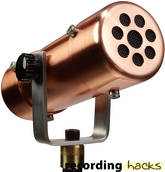 Placid Audio Copperphone
Placid Audio Copperphone
Cardioid Dynamic Microphone
The Placid Audio Copperphone is a moving-coil dynamic microphone designed as an effect microphone.
An “effect microphone” is a microphone that heavily colors and modifies the sound at the source rather than relying on further processing, such as distortion and filtering.
The Copperphone’s internals are built into a durable, machined copper housing, hence the name. Inside the housing, the 1.75-inch diameter moving-coil cartridge is ported into a tuned resonant chamber that accentuates the upper midrange frequencies while reducing the lows and highs. This mechanical pathway gives the Copperphone its distinct character; no electronic filtering is used.
The story of the Copperphone’s creation illustrates creator Mark Pirro’s design goals and usage suggestions:
In 2001, Polyphonic Spree/Tripping Daisy frontman Tim DeLaughter was using an outboard effect unit in the studio to filter his voice to create an “AM radio” sound. The outboard unit worked well in the studio but when the band brought it on tour it became challenging to use live. Bassist Mark Pirro thought it would be useful to have a microphone that got that AM radio sound from the source, and the Copperphone was born. Tim DeLaughter received the first production model.
While the Copperphone is a simple, one-stop solution for “that AM radio sound” on vocals, it has also found use with several high-profile engineers and producers as a blend mic. That is, the Copperphone’s signal is recorded alongside (and presumably phase-aligned with) that of a more traditional microphone to achieve subtle coloration on a vocal or instrument.
The mic can also be used on stage, though Pirro says to use common sense guidelines when doing so. For instance, the Copperphone — like any microphone — has limits and is not immune to feedback, so loud monitor levels should be avoided. Using in-ear monitors would of course remove any feedback problems entirely, but for those without in-ear monitors, Pirro recommends removing the Copperphone signal from the monitors altogether:
Mark Pirro, Placid Audio
Once band stage volume and general monitor levels are set, small amounts of the Copperphone can be dialed back into the monitors up to the feedback threshold. Little or no Copperphone in the monitors will still produce acceptable results because the Copperphone delivers a robust midrange character that can easily be heard through the front of house speakers.
Very high SPL can overdrive the diaphragm but will not damage the microphone. If high SPLs are required, Placid Audio’s Resonator series may be a more suitable choice. (See sidebar link.)
The Copperphone comes with an adjustable aircraft aluminum mounting bracket, and is fitted with a Switchcraft XLR connector.
Permalink: Placid Audio Copperphone
The mic was released in 2003.
Specifications
| Pickup Patterns | Pads & Filters |
|---|---|
|
Cardioid
(200 - 3,000) |
|
| Coil Diameter | Impedance | SPL/Noise |
|---|---|---|
| n/a | 150 Ohms (Low) | SPL n/a |
| Weight | Length | Max Diameter | Interface(s) |
|---|---|---|---|
| 794g (28.01oz) | 152mm (5.98'') | n/a |
|
| Power Specifications |
|---|
Did we get anything wrong on this page? Please let us know!

